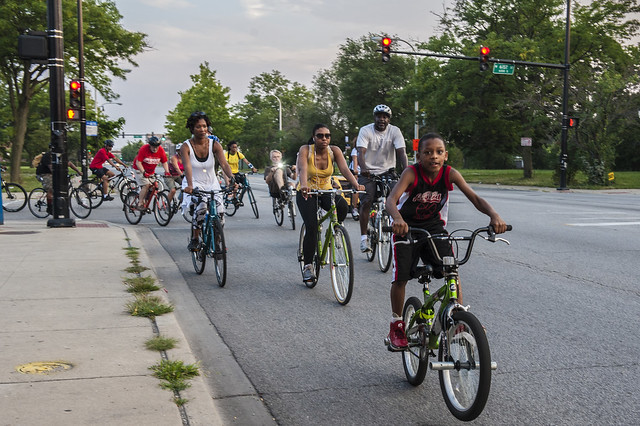
Earlier this month, the League of American bicyclists released a report with a method for using Census info and geographic information system data to measure how well bicycle networks serve communities that have the greatest need for better infrastructure. Using Chicago as the case study, the author concluded that the city’s “planned network” of new bikeways wouldn’t provide a fair share of access to African-American and Latino communities.
The thing was, the “planned network” map that the report analyzed wasn’t actually the planned network from the Streets for Cycling Plan 2020 – it was actually based on old “recommended routes” from the city’s bike map. After two Streetsblog Chicago posts about the problem, the League finally overhauled the report with the correct map data and reached the opposite conclusion: The 2020 Plan will significantly boost bikeway equity for communities of color.
In the midst of lobbying the LAB to fix the report, I emailed local sustainable transportation leaders to get their thoughts on the topic. Active Transportation Alliance cofounder Randy Neufeld, now with the SRAM Cycling Fund, had a response that put the bike equity issue in perspective.
“A GIS exercise that relates lines on a map or a plan to demographic information is not a useful equity analysis,” he argued. “Those lines are not all the same thing. They represent very different conditions in different places. Plus, just because there's a Crosstown Bike Route within a certain distance of your house doesn't mean you live in a bikeable neighborhood…what's fair and equitable as far as neighborhood bikeways is very different.”
Neufeld added that equity analysis is worth doing, but it’s going to take more than studying a map to determine how to make Chicago’s bike network more equitable. “Aldermanic leadership is key,” he said. “We have a few wards with bike-ped-transit committees. Maybe we need some more.” He suggested that a simple criteria could be devised for a ward cycling audit, which could help gauge the relative levels of bikeability in different parts of the city. That would better inform decisions about where new bike lanes and paths should be prioritized, he said.
“Finally how does the bicycle renaissance happen in Chicago?” Neufeld concluded. “Does it happen incrementally and uniformly throughout the city? I don't think so.” He noted that, while Chicago has made admirable progress towards becoming more bike-friendly, there still isn’t a neighborhood in the city with a comfortable all-ages cycling network. “Some ward or neighborhood needs to lead the city to build a world-class system by prioritizing bikeway development over the car's unsustainable hegemony on street space.”
Conventional wisdom suggests that an affluent North Side neighborhood will take the lead in becoming the city’s first truly bike-friendly community. However, Neufeld said it would be exciting if a low-to-moderate-income Latino, African-American or mixed neighborhood on the South or West Side pioneered this idea. “Every place has its assets and challenges,” he concluded. “Let's encourage and support bikeway development in the neighborhoods that could benefit most. That's real equity.”
Updated 9/25/15
In response to Neufeld's comments, League spokeswoman Elizabeth Murphy requested that Streetsblog Chicago post the following passage from the LAB's report, "Equity of Access to Bicycle Infrastructure":
There is no single best way to measure access and bicycle equity for the variety of cities where bicycle equity is in question. However, this report provides a framework for how GIS can be used as a tool in decision-making and advocacy efforts with the understanding and provision that every community has a unique perspective, values, and equity concerns and may choose to apply different criteria to creating their own understanding of equity.





